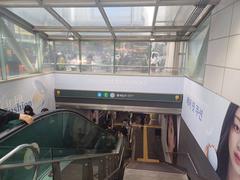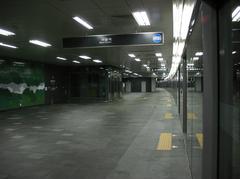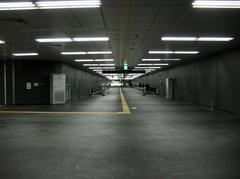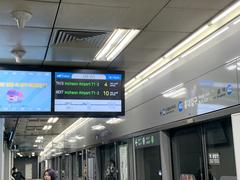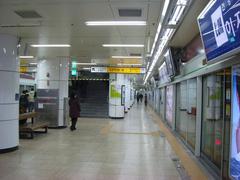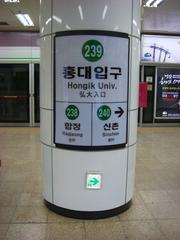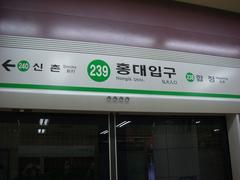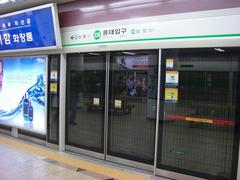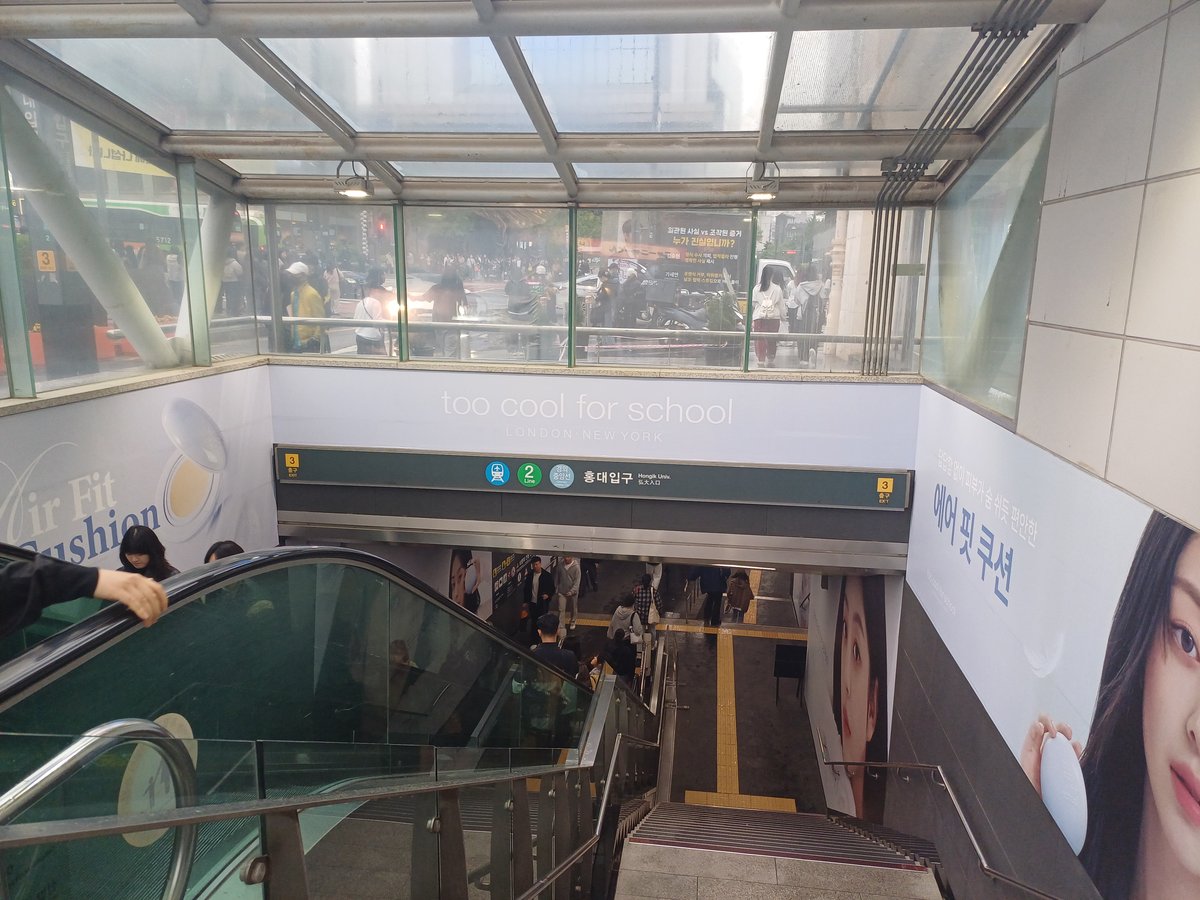
Complete Guide to Visiting Hongik University Station, Seoul, South Korea: Tickets, Hours, and Nearby Attractions
Date: 14/06/2025
Introduction
Hongik University Station—often called “Hongdae Station”—is much more than a subway stop. Situated in Mapo-gu, Seoul, it serves as the bustling gateway to the Hongdae district, famed for its artistic vibrancy, indie music culture, and youthful energy. Anchored by Hongik University, renowned for its fine arts and design programs, the station and its surroundings have evolved into a cultural epicenter, attracting creatives, students, travelers, and locals alike. This guide provides detailed information on the station’s operational hours, ticketing, accessibility, transport options, and must-see attractions, while delving into the historical and cultural fabric that makes Hongdae a top Seoul destination.
Table of Contents
- History and Evolution of Hongik University Station and Hongdae
- Practical Information: Hours, Tickets, Accessibility
- Transportation: Subway, Airport, Bus, and Taxi
- Art, Culture, and Urban Identity
- Urban Development and Gentrification
- Contemporary Hongdae and Nearby Attractions
- Hongdae Mural Street: A Visitor’s Guide
- Dining, Shopping, and Visitor Tips
- Frequently Asked Questions (FAQ)
- Conclusion and Call to Action
- Sources and Further Reading
History and Evolution of Hongik University Station and Hongdae
Early Development and University Influence
Hongik University Station’s story is inseparable from Hongik University, established in 1948 and relocated to Mapo-gu in 1955 (Creatrip). The university’s focus on fine arts and design shaped the district’s identity, with “Hongdae” deriving from the Korean words for “Hongik” and “Daehakgyo” (university) (The Seoul Guide). In the 1960s, campus restructuring heightened the area’s creative concentration, laying the foundation for an artistic community (Noel in Seoul).
Emergence of Artistic and Indie Culture
Through the 1970s and ’80s, the area blossomed into an art-centric hub, with “Art Academy Street” forming a corridor of galleries, studios, and shops. The liberalization of the 1990s and affordable rents attracted musicians and performers, sparking Korea’s indie music movement. Local venues hosted pioneering acts like Sister’s Barbershop and Crying Nut, establishing Hongdae’s reputation as Seoul’s underground arts and club capital (Wikipedia).
Infrastructure Expansion and Urban Transformation
The introduction of Seoul Metro Line 2 in 1984, followed by Line 6, the AREX (Airport Railroad Express), and the Gyeongui–Jungang Line, made Hongdae ever more accessible (Noel in Seoul). As nearby districts waned, Hongdae’s popularity surged. Exit 9 became a legendary meeting spot, earning the humorous nickname “People’s Hell” for its weekend crowds (Creatrip).
Practical Information: Hours, Tickets, Accessibility
- Station Hours: Open daily from approximately 5:30 AM to midnight.
- Ticketing: Single-ride fares start at 1,350 KRW. T-Money cards provide seamless travel across subways, buses, and taxis. Purchase/recharge at stations or convenience stores.
- Accessibility: Elevators, escalators, tactile paving, and multilingual signage make the station accessible to all. Exit 7 (AREX) and Exit 8 (Line 2) have elevators; barrier-free transfers connect all lines.
- Visitor Tips: Avoid peak hours (weekday mornings/evenings, weekend nights) for a more relaxed experience.
Transportation: Subway, Airport, Bus, and Taxi
Subway Connectivity
Hongik University Station is a major interchange for:
- Line 2 (Green Line): Circles central Seoul, connecting districts like Gangnam and Sinchon (CK Travels).
- Airport Railroad Express (AREX): Directly links to Incheon (54–59 min) and Gimpo airports (14 min). The AREX All-Stop train is a regular subway; the Express does not stop here (KoreaToDo).
- Gyeongui–Jungang Line: Connects east-west through Seoul, reaching Yeonnam-dong and beyond.
Airport and Bus Transfers
- Airport Limousine Bus #6002: Runs from Incheon Airport to Hongdae (about 60 min), stopping near Exit 2.
- Night Buses: N6000, N26, and N62 serve the area; taxis are readily available.
Local Bus and Taxi
City buses and taxis connect Hongdae to the rest of Seoul. Navigation apps like Naver Map and Kakao T are recommended.
Art, Culture, and Urban Identity
Street Art and Performance
Hongdae’s streets are famed for vibrant murals and graffiti, especially along Hongdae Mural Street (“Picasso’s Street”) (Wikipedia). Street performances by musicians, dancers, and artists are a daily spectacle, particularly on weekends (Particle Seoul).
Indie Music and Nightlife
Live venues and clubs sustain Hongdae’s indie music reputation, even as commercialization grows. Friday and Saturday nights are especially lively (Creatrip).
Literary and Publishing Hub
With over 3,000 publishing companies nearby, Hongdae is also a literary center. Gyeongui Line Book Street is a must for book lovers (Creatrip).
Festivals and Markets
The Hongdae Free Market (Saturdays, March–November, 1:00–6:00 PM) is a showcase for young artists and artisans (Particle Seoul).
Urban Development and Gentrification
The 2000s saw a surge in commercialization and rising rents, leading some artistic venues to relocate. Despite these pressures, Hongdae’s creative spirit continues, with Yeonnam-dong, Hapjeong, and Sangsu offering alternative hotspots (ArchDaily).
Contemporary Hongdae and Nearby Attractions
- World Cup Stadium: A short metro ride away.
- Gyeongui Line Book Street: Literary enclave near the station.
- Yeontral Park (Gyeongui Line Forest Park): Urban green space.
- Live Music Venues and Trendy Cafés: Scattered throughout Hongdae, Yeonnam-dong, and Hapjeong.
Hongdae Mural Street: A Visitor’s Guide
Overview
Hongdae Mural Street is a free, open-air gallery showcasing local street art. Accessible year-round, it’s best enjoyed during the day for vibrant photo opportunities. Guided tours are available, and special events occur seasonally. The street is mostly accessible, though some sections are narrow or cobblestoned.
Directions and Tips
- Getting There: From Hongik University Station, Exit 9, walk towards Hongdae’s cultural district.
- Visitor Tips: Wear comfortable shoes, avoid peak times for fewer crowds, and respect the art by not touching murals.
- Nearby: Explore Hongdae Free Market, shopping streets, and indie music venues.
Dining, Shopping, and Visitor Tips
- Food: Sample tteokbokki, hotteok, and Korean fried chicken from street stalls or themed cafés.
- Shopping: Discover independent designer boutiques, vintage shops, and K-beauty stores.
- Safety: The area is lively and well-monitored. Keep valuables secure, especially during busy nights.
Frequently Asked Questions (FAQ)
Q: What are Hongik University Station’s operating hours?
A: Daily from approximately 5:30 AM to midnight.
Q: How do I buy subway or AREX tickets?
A: Use station kiosks or T-Money cards, valid across subway, bus, and taxi networks.
Q: Is the station accessible for those with disabilities?
A: Yes, elevators, escalators, tactile paving, and accessible restrooms are available.
Q: Are there guided tours of Hongdae and the murals?
A: Yes, local companies offer tours covering street art, music, and food.
Q: Which exits are best for nightlife and shopping?
A: Exit 9 leads directly to Hongdae’s main shopping and entertainment area.
Conclusion and Call to Action
Hongik University Station is a vibrant entry point to Seoul’s most dynamic neighborhood—an intersection of art, music, literature, and youthful energy. With excellent transport connections, accessible facilities, and endless cultural attractions, Hongdae is a must for any visitor seeking an authentic and creative Seoul experience. Plan your journey with real-time updates and guides from the Audiala app, and explore more on related Seoul travel topics.
Stay Connected: Download the Audiala app for the latest travel news, guides, and insider tips. Visit the Hongik University Tourist Information Center for up-to-date event information and support. For more inspiration, check out our articles on “Seoul Subway Travel Tips,” “Top Cultural Festivals in Seoul,” and “Best Cafes in Hongdae.”
Suggested Visuals: Include high-quality images of the Hongik University Station entrance, Hongdae Free Market, Mural Street, and live performances, using descriptive alt tags for SEO.
Sources and Further Reading
- Hongik University Station: Historical Background and Cultural Significance, 2025, Creatrip (https://creatrip.com/en/blog/10630)
- Hongdae (area), 2025, Wikipedia (https://en.wikipedia.org/wiki/Hongdae_(area))
- Hongik University Station Visitor Guide, 2025, Noel in Seoul (https://noelinseoul.com/hongdae-hongik-university-street/)
- Hongik University Station Visiting Hours, Tickets, and Transportation Options, 2025, KoreaToDo (https://www.koreatodo.com/hongdae-hongik-university-street)
- Things to Do in Hongdae Seoul, 2025, CK Travels (https://www.cktravels.com/things-to-do-hongdae-seoul/)
- Hongdae Free Market and Street Culture, 2025, Particle Seoul (https://particleseoul.tistory.com/918)
- Hongik University New Campus Design, 2025, ArchDaily (https://www.archdaily.com/1010006/oma-chris-van-duijn-wins-bid-to-design-hongik-universitys-new-campus-in-seoul)
- Hongik University Tourist Information Center, 2025, Seoul Danurim (https://www.seouldanurim.net/en/inforcenter/D/TOURINFOTYPE6/35812)
- The Seoul Guide: Hongdae Area Overview, 2025 (https://www.theseoulguide.com/hongdae-hongik-university-area/)
